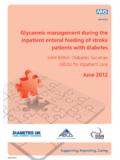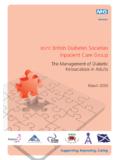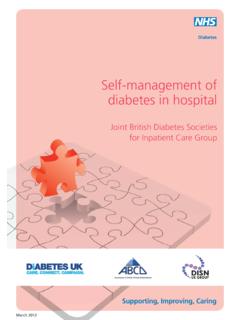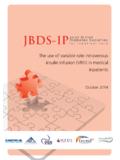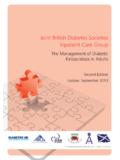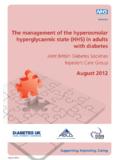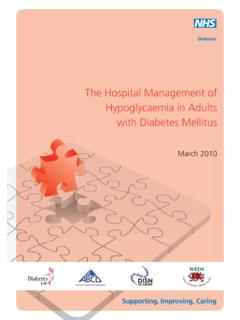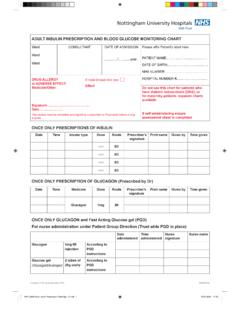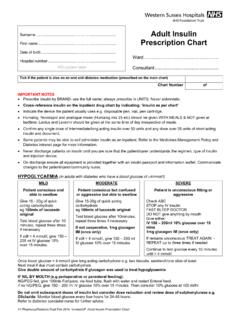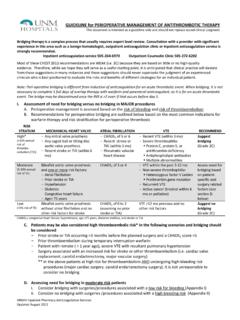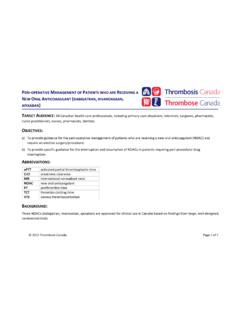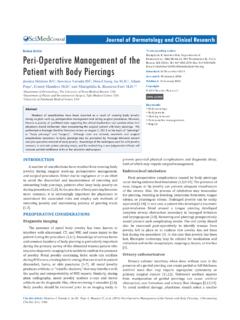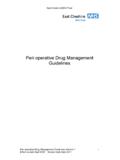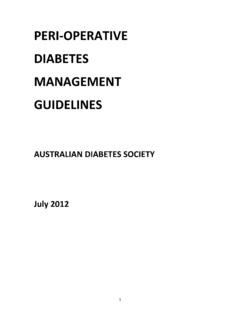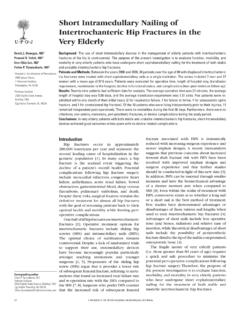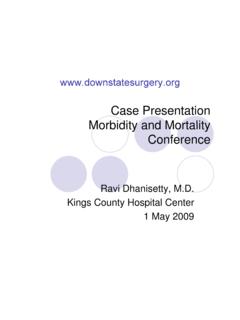Transcription of Management of adults with diabetes undergoing surgery …
1 Management of adults withdiabetes undergoing surgery andelective procedures:improving standardsApril 2011 Supporting, Improving, CaringPrimary carereferralPre-operativeassessmentPost- operativecareSurgical outpatientsHospitaladmissionTheatreand recoveryDischargeAuthors:Ketan Dhatariya Consultant in diabetes , Norfolk & Norwich University Hospital Daniel Flanagan Consultant in diabetes , Plymouth HospitalLouise Hilton Senior diabetes Nurse, Bolton PCTAnne Kilvert Consultant in diabetes , Northampton General HospitalNicholas Levy Consultant Anaesthetist, West Suffolk HospitalGerry Rayman Consultant in diabetes , Ipswich HospitalBev Watson Consultant Anaesthetist, Queen Elizabeth Hospital, Kings LynnContributors:David Cousins Head of Patient Safety for Medication and Medical Devices, NPSAC arol Jairam diabetes Specialist Nurse, Charing Cross HospitalKaren Leyden Consultant Anaesthetist, Northampton General HospitalDileep Lobo Professor of surgery , Queens Medical Centre, NottinghamMaggie Sinclair-Hammersley Consultant in diabetes , John Radcliffe Hospital, OxfordAcknowledgement:Richard Grimsdell for the logo design3 These guidelines have been commissioned by NHS diabetes and written by the Joint British DiabetesSocieties Inpatient Care Group and representatives from the specialist societies surgeons andanaesthetists.
2 The document has also been informed by focus groups from diabetes UK. The aim of theguidelines is to improve standards of care for people with diabetes undergoing operative or investigativeprocedures requiring a period of audienceThe guidelines emphasise the need for patient centred care at every stage and we hope that they will beof use to all healthcare professionals whose work brings them into contact with this vulnerable group target audience specifically includes: General practitioners, practice nurses and district nurses Pre- operative assessment nurses Anaesthetists Surgeons Trainee medical staff Post- operative recovery and surgical ward nurses Diabetologists diabetes inpatient specialist nurses, diabetes specialist nurses and educators Hospital pharmacists Hospital managers Commissioners importantly, this document is addressed to those writing and implementing local perioperative carepolicies and to medical and nursing educators.
3 Managers have a responsibility to ensure that guidelinesbased on these recommendations are put in place. The guidelines aim to cover all stages of the patientpathway but are not designed to be read from cover to cover. Recommendations for each stage areintended to stand alone so that individual health care professionals can identify their role in the process. These are the first UK national guidelines in this area of diabetes care and the first to address the wholepathway from referral to discharge. They will be a resource for those responsible at every stage of thepathway for the care of the surgical patient with diabetes . We wish to congratulate the authors on producing clearly written, comprehensive, practical and easy tofollow documents in a complex area of diabetes care. We thoroughly recommend the guidelines todiabetes, surgical, anaesthetic and primary care Gerry RaymanAnna MortonNHS diabetes Clinical Lead for Inpatient diabetes CareDirector of NHS DiabetesForeword4 Primary carereferralPre-operativeassessmentPost- operativecareSurgical outpatientsHospitaladmissionTheatreand recoveryDischarge5 Main recommendations7 Introduction8 Factors leading to adverse outcomes 11 Standards of care for people with diabetes12 The metabolic response to surgery and the effect of diabetes14 Guidelines for peri- operative diabetes care15 Primary care 18 Surgical outpatients19 Pre- operative assessment 20 Hospital admission21 Factors influencing the choice of peri- operative diabetes management22 Fluid Management for patients requiring a variable rate intravenous insulin infusion24 Fluid Management for patients not requiring a variable rate intravenous insulin infusion24 Special circumstances26 Theatre and recovery27 Post- operative care29
4 Safe use of insulin30 Discharge31 Controversial areas 34 Glycaemic control34 Fluid and insulin36 Fluid Management in patients requiring a variable rate intravenous insulin37infusion (VRIII)Long acting insulin analogues and evening lists39 Prevention of pharmacological iatrogenic incidents in the surgical patient with diabetes40 Audit Standards43 Appendix 1:Guideline for peri- operative adjustment of insulin 47 Appendix 2:Guideline for peri- operative adjustment of non-insulin medication 48 Appendix 3:Guidelines for suitability of patients with diabetes for day case surgery49 Appendix 4:Guideline for peri- operative monitoring of diabetes and Management of 50hyperglycaemia and hypoglycaemia in patients undergoing surgery with a short starvation period Appendix 5:Guideline for the use of a variable rate intravenous insulin infusion (VRIII)52 Appendix 6:Advantages and disadvantages of intravenous solutions54 Appendix 7:Transferring from a VRIII to subcutaneous insulin or oral treatment56 Appendix 8:Examples of patient information leaflets for patients undergoing surgery or 58procedures requiring a period of starvationAppendix 9:Example of instructions for non- operative procedures requiring a period of 62starvationAppendix 10:Sick day rules for people with diabetes63 Appendix 11:Discharge letter: Advice for patients with diabetes who are discharged following 64a surgical procedureAppendix 12:GP letter with recommendations for referral of patients for surgery65 References66 Contents6 Comprehensive care pathway for peri- operative Management of diabetesThese guidelines cover all stages of the patient pathway from primary care referral to surgical outpatients,pre- operative assessment, hospital admission, surgery , post- operative care and discharge.
5 The processshould be seamless, with advance planning guidelines are primarily intended for the Management of patients with diabetes referred for electivesurgery. However, most of the recommendations can be applied to the patient presenting for emergencysurgery with the proviso that many such patients are high risk and are likely to require an intravenousinsulin infusion and level 1 care (acute ward with input from critical care team) as a carereferralPre-operativeassessmentPost- operativecareSurgical outpatientsHospitaladmissionTheatreand recoveryDischarge7 Organisation and planning of care1. Careful planning, taking into account the specificneeds of the patient with diabetes , is required at allstages of the patient pathway from GP referral topost- operative discharge. 2. The patient should be involved in planning for allstages. 3. Hospital patient administration systems shouldbe able to identify all patients with diabetes sothey can be prioritised on the operating High-risk patients (poor glycaemiccontrol/complications of diabetes ) should beidentified in surgical outpatients or at pre-operativeassessment and plans should be put in place tomanage their Early pre- operative assessment should be arrangedto determine a peri- operative diabetesmanagement strategy and to identify and optimiseother Routine overnight admission for pre-operativemanagement of diabetes should not be necessary.
6 7. Starvation time should be minimised by prioritisngpatients on the operating Surgical and anaesthetic principles of the EnhancedRecovery Partnership Programme should beimplemented to promote earlier mobilisation withresumption of normal diet and return to usualdiabetes Multi-modal analgesia should be combined withappropriate anti-emetics to enable an early returnto normal diet and usual diabetes The patient should resume diabetes self- Management as soon as possible A policy which includes plans for diabetesmanagement should be in place for safedischarge. 12. Outcomes should be audited specialists13. Clear guidelines should indicate when thediabetes specialist team should become All hospitals should implement a DiabetesInpatient Specialist Nurse (DISN) use of intravenous insulin15. The term variable rate intravenous insulininfusion (VRIII) should replace the ambiguousterm sliding scale.
7 16. patients with a planned short starvation period (nomore than one missed meal in total) should bemanaged by modification of their usual diabetesmedication, avoiding a VRIII wherever possible. 17. patients expected to miss more than one mealshould have a The recommended first choice substrate solutionfor a VRIII is sodium chloride with 5%glucose and either potassium chloride(KCl) or Insulin should be prescribed according to NationalPatient Safety Agency (NPSA) recommendationsfor safe use of blood glucose monitoring20. Capillary blood glucose (CBG) levels should bemonitored and recorded at least hourly during theprocedure and in the immediate Hospitals should have clear guidelines for themanagement of blood glucose when it is outsidethe acceptable Training for blood glucose measurement anddiabetes Management should be introduced forclinical staff caring for patients with The WHO surgical safety checklist bundle shouldbe implemented.
8 The target blood glucose shouldbe 6-10 mmol/L (acceptable range 4-12 mmol/L).Main recommendations8 diabetes is the most common metabolic disorder,affecting at least 4-5% of people in the UK. Overthe next decade the exponential rise in obesity ispredicted to increase the prevalence of diabetes bymore than 50%. This has major implications forhealth services, with particular impact on inpatientcare. A recent audit has shown that the prevalenceof diabetes in the UK inpatient population nowranges from 10-28%, exceeding previousestimates by at least 50%1and this figure is certainto rise in the future. Because diabetes related co-morbidities increase the need for surgical andother operative procedures, it is not surprising thatat least 10% of patients undergoing surgery havediabetes and this percentage is also likely to leads to increased morbidity andincreased length of stay, whatever the admissionspecialty, thereby increasing inpatient costs.
9 This isa particular problem in surgical patients where theexcess bed days were recently estimated to be45% greater than for people with diabetesadmitted to medical wards2. The peri-operativemortality rate is reported to be up to 50% higherthan that of the non-diabetic population3. Thereasons for these adverse outcomes aremultifactorial but include: Hypo and hyperglycaemia Multiple co-morbidities including microvascularand macrovascular complications Complex polypharmacy, including misuse ofinsulin Inappropriate use of intravenous insulin infusion Management errors when converting from theintravenous insulin infusion to usual medication Peri- operative high-risk surgical patient and theimpact of diabetesThe high-risk surgical population is made up ofelderly patients with co-existing medical conditionsundergoing complex or major surgery , often as anemergency. The most important co-morbiddiseases include ischaemic heart disease, heartfailure, respiratory disease, impaired renal functionand diabetes mellitus.
10 There is clear evidence thatsuch diseases are strongly associated with pooroutcomes after major related patient factorsassociated with worse outcomesPoor peri- operative glycaemia controlGlycaemic control has a significant impact on therisk of post- operative infection across a variety ofsurgical specialities3. Post- operative glycaemiccontrol significantly influences the healing of deepsternal wound infection after open heart surgery8and has been shown to have a similar on impacton healing in other forms of surgery3. The 2009 National Inpatient diabetes Survey found that 25%of patients on surgical wards experienced ahypoglycaemic event and inpatient hypoglycaemiais associated with increased mortality1. Diabeticketoacidosis, though completely avoidable, stilloccurs on surgical wards and can result in post- operative death9. Complications of diabetesDiabetes is associated with a two to four foldincrease in cardiovascular disease includinghypertension, coronary artery disease and majority of people with diabetes booked forIntroductionPrimary carereferralPre-operativeassessmentPost- operativecareSurgical outpatientsHospitaladmissionTheatreand recoveryDischarge9surgery are likely to have one or more of thesecardiovascular diseases and a significant numberwill have microvascular disease (nephropathy orneuropathy).
